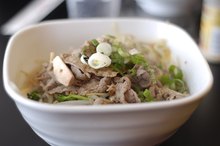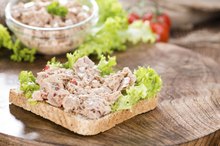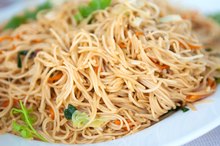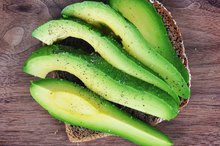What does fact checked mean?
At Healthfully, we strive to deliver objective content that is accurate and up-to-date. Our team periodically reviews articles in order to ensure content quality. The sources cited below consist of evidence from peer-reviewed journals, prominent medical organizations, academic associations, and government data.
- Mayo Clinic; Exercise for Weight Loss: Calories Burned in 1 Hour; December 2009
- Mayo Clinic; Dietary Fats: Know Which Types to Choose; February 2011
- "The British Journal of Nutrition"; Effects of a High-Protein, Low-Carbohydrate v. High-Protein, Moderate-Carbohydrate Weight-Loss Diet on Antioxidant Status, Endothelial Markers, and Plasma Indices of the Cardiometabolic Profile; A.M. Johnstone et al.; April 2011
- "The British Journal of Nutrition"; Effects of a High-Protein, Low-Carbohydrate v. High-Protein, Moderate-Carbohydrate Weight-Loss Diet on Antioxidant Status, Endothelial Markers, and Plasma Indices of the Cardiometabolic Profile; A.M. Johnstone et al.; April 2011
- American Heart Association; Know Your Fats; May 2011
The information contained on this site is for informational purposes only, and should not be used as a substitute for the advice of a professional health care provider. Please check with the appropriate physician regarding health questions and concerns. Although we strive to deliver accurate and up-to-date information, no guarantee to that effect is made.
The Nutritional Value of Beef Sweetbreads
Despite the name, sweetbreads are neither sugary treats nor dough-based products, but rather consist of the pancreas and gullet of animals. Beef sweetbreads are derived from cows and are rich in protein, but are also high in fat. Beef sweetbreads are high in calories, so they may not be appropriate for dieting. Beef sweetbreads can be breaded and fried, but are also served roasted or grilled.
Calories
Beef sweetbread is calorie-dense, as a 4 oz. cooked portion provides 360 calories. This amount comprises 18 percent of the daily suggested intake of 2,000 and is more than other beef products, such as sirloin steak, which contains 145 calories per 4 oz. serving. Beef sweetbread is not ideal for dieting, as it would take 42 minutes of swimming laps or one hour and 39 minutes of weightlifting to burn 360 calories.
- Beef sweetbread is calorie-dense, as a 4 oz.
Fat
The Nutrition of Pho Soup
Learn More
Beef sweetbreads are high in fat. Each 4 oz. serving of this food contains 28 g of fat, with nearly 10 g of saturated fat. Dietary fat is a required nutrient for proper health, although too much can hinder your attempts to manage your weight, as it is calorie-dense. Additionally, too much saturated fat may increase your risk of heart disease. To limit your risk for heart disease, restrict saturated fat intake to just 15 g each day.
- Beef sweetbreads are high in fat.
- Dietary fat is a required nutrient for proper health, although too much can hinder your attempts to manage your weight, as it is calorie-dense.
Protein
Beef sweetbreads are a rich source of protein, with 25 g in each 4 oz. portion. Protein is a vital nutrient because it provides your body with the amino acids it needs to build and repair body tissues and carry out other important functions. A 4 oz. serving of beef sweetbreads provides 1 g more protein than a 4 oz. serving of sirloin steak.
- Beef sweetbreads are a rich source of protein, with 25 g in each 4 oz.
- serving of beef sweetbreads provides 1 g more protein than a 4 oz.
Carbohydrates
Can Tuna Salad Help You Lose Weight?
Learn More
Beef sweetbreads do not contain any carbohydrates. Carbohydrates fuel your body with energy, so consuming them can be beneficial for exercise. However, limiting carbohydrates may be beneficial in certain circumstances; a study from the April 2011 issue of "The British Journal of Nutrition" suggests that a diet high in protein but low in carbohydrates can produce more weight loss than higher carbohydrate meal plans 3. Though it is important to always check with your doctor before beginning any diet plan, as your needs may be different.
- Beef sweetbreads do not contain any carbohydrates.
- Carbohydrates fuel your body with energy, so consuming them can be beneficial for exercise.
Cholesterol
Beef sweetbread is high in cholesterol. Each 4 oz. serving contains 332 mg of cholesterol, which is 110 percent of the daily suggested intake. A high cholesterol intake may increase your risk of cardiovascular disease, so the American Heart Association suggests a limit of 300 mg each day 4.
- Beef sweetbread is high in cholesterol.
- A high cholesterol intake may increase your risk of cardiovascular disease, so the American Heart Association suggests a limit of 300 mg each day 4.
Related Articles
References
- Mayo Clinic; Exercise for Weight Loss: Calories Burned in 1 Hour; December 2009
- Mayo Clinic; Dietary Fats: Know Which Types to Choose; February 2011
- "The British Journal of Nutrition"; Effects of a High-Protein, Low-Carbohydrate v. High-Protein, Moderate-Carbohydrate Weight-Loss Diet on Antioxidant Status, Endothelial Markers, and Plasma Indices of the Cardiometabolic Profile; A.M. Johnstone et al.; April 2011
- American Heart Association; Know Your Fats; May 2011
- Beef, ground, 85% lean meat / 15% fat, crumbles, cooked, pan-browned. FoodData Central. U.S. Department of Agriculture. Published April 1, 2019.
- US Department of Agriculture. MyPlate: Nutrients and health benefits.
- Clifford J, Curely J. Water-soluble vitamins: B-complex and vitamin C. Colorado State University Extension. Updated December 2019.
- National Institutes of Health Office of Dietary Supplements. Iron: Fact sheet for health professionals. Updated February 28, 2020.
- American College of Allergy, Asthma and Immunology. Meat allergy. Updated May 8, 2019.
- Song M, Garrett WS, Chan AT. Nutrients, foods, and colorectal cancer prevention. Gastroenterology. 2015;148(6):1244-60.e16. doi:10.1053/j.gastro.2014.12.035
- Wolk A. Potential health hazards of eating red meat. J Intern Med. 2017;281(2):106-122. doi:10.1111/joim.12543
- Daley CA, Abbott A, Doyle PS, Nader GA, Larson S. A review of fatty acid profiles and antioxidant content in grass-fed and grain-fed beef. Nutr J. 2010;9:10. doi:10.1186/1475-2891-9-10
Writer Bio
Brian Willett began writing in 2005. He has been published in the "Buffalo News," the "Daytona Times" and "Natural Muscle Magazine." Willett also writes for Bloginity.com and Bodybuilding.com. He is an American Council on Exercise-certified personal trainer and earned a Bachelor of Arts in journalism from the University of North Carolina.









